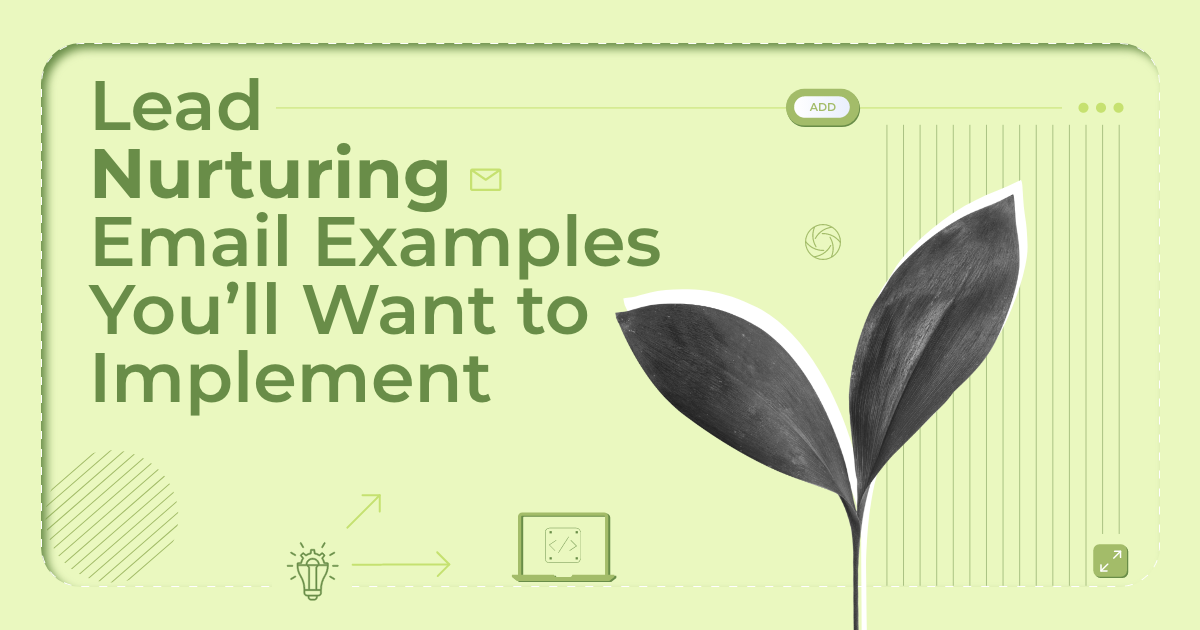
Your Guide To Email Marketing For Construction Companies [2026]
What if you could easily showcase your latest projects, keep your clients in the loop, and stay fresh in their minds for future work? Well, email marketing might not be the first tactic that comes to mind to do so, but it’s incredibly effective, offering a simple way to achieve these goals and more.
If you’re new to the digital marketing world, starting with email marketing might feel overwhelming. Crafting engaging and effective emails and figuring out how to measure their success can be tricky.
In this post, we’ll discuss why email marketing for construction companies is a must for modern constructors, highlighting the benefits you’ll gain. Additionally, we’ll show you how easy it is to create your own strategy, providing examples and tips to make the most of this opportunity.
What Is Email Marketing for Construction Companies?
Email marketing is a digital marketing strategy that involves sending targeted, personalized email messages to customers and prospects.
For construction businesses, it can help you drive sales and book more projects. Also, you can strengthen connections with clients, architects, and subcontractors, boost brand loyalty, and share important updates and content about your business.
Blueprints stuck on the drawing board?
Build effective email campaigns that turn leads into closed deals.
Try MoosendWhy Is Email Marketing Important for Construction Companies?
Email marketing is valuable to your construction company’s marketing efforts for several reasons. As mentioned above, you can use email to build better customer relationships and promote your brand.
Let’s look at the main benefits in more detail.
Lead nurturing
Email marketing helps build connections with potential clients and existing customers, leading to more project inquiries and sales.
Consequently, nurturing relationships with your construction clients will lead to increased customer loyalty and, through repeat business, and to a higher customer lifetime value (CLV).
Targeted communication
Another benefit of email marketing is delivering highly relevant content to specific segments of your target audience.
Construction professionals often contact diverse groups, including home buyers, potential customers, subcontractors, and existing clients.
Email marketing allows you to tailor your communication to these segments through audience segmentation. This keeps your brand top-of-mind, increases recognition and awareness, and positions you as a leader in the construction industry by consistently delivering valuable content.
Workflow automation
Email marketing software will let automate your workflows to save time on repetitive tasks and increase your efficiency.
For example, you can automate email sequences like welcome emails, project updates, email newsletters, and nurturing sequences to maintain consistent and timely communication with minimal manual input from you or your team.
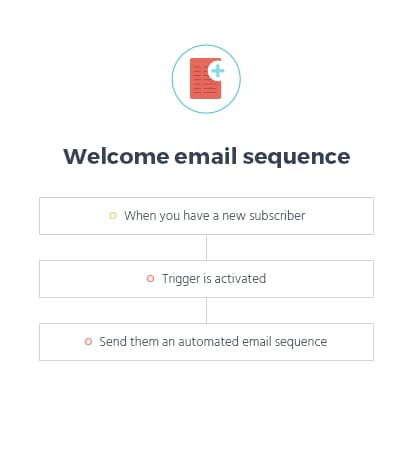
Many marketing automation tools like Moosend will provide you with pre-made recipes to create your first sequence. This is very useful for beginners and those who want to save time.
Cost-effective growth
Email marketing is exceptionally low-cost compared to traditional marketing channels. That’s because, beyond paying for your email service provider, there aren’t any further costs associated with designing and sending your construction email marketing campaigns.
The low cost doesn’t mean low results, though. In fact, email marketing has an average ROI of $42 for every $1 spent.
Keep in mind that the cost will go up if you decide to work with specialist designers or an email marketing agency. Nevertheless, you can avoid this by using pre-made, customizable email templates to keep the cost low and have control over your design.
How to Create a Construction Company Email Marketing Strategy
The construction industry is highly competitive by nature. Therefore, it’s important to have a comprehensive lead generation and relationship-nurturing strategy. This is where email marketing comes in.
Below is a step-by-step guide with actionable tips to help you get started with construction email marketing, attract new customers, and increase customer lifetime value.
1. Build your email list
Your email list is the list of email addresses and other contact information, like names and demographics, of the people who consented to receive updates and promotional content from your construction business.
There are several strategies you can implement to build your email list:
- Lead capture forms: website pop-ups and whitepaper downloads.
- Industry events: collect email addresses from prospective customers and industry peers.
- Customer feedback forms: distributed after a customer has interacted with your business, such as after project completion.
- Social media promotions: ads with a clear call-to-action guiding the reader to sign up.
Here’s a simple form example found on Bechtel’s construction website:
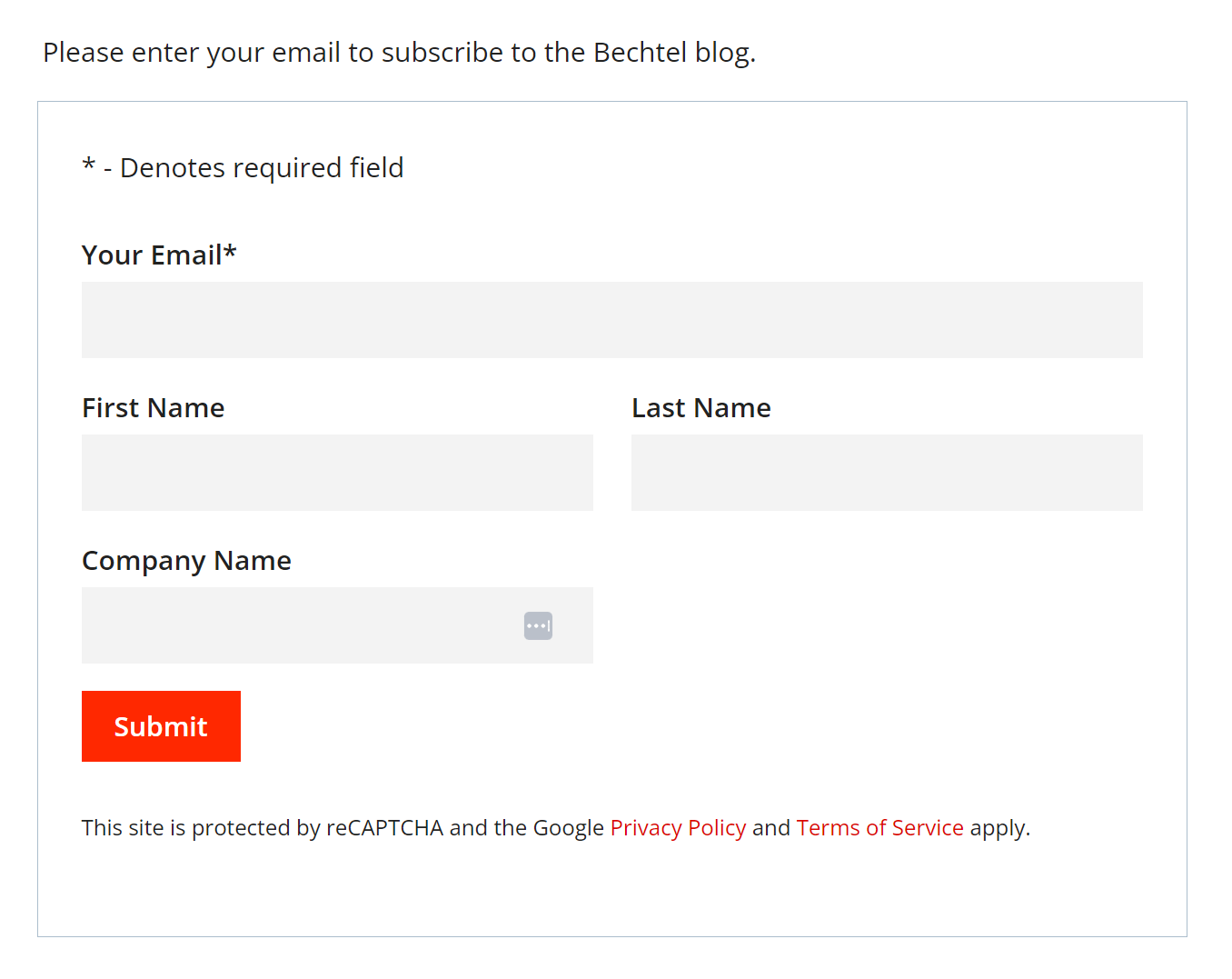
Once you’ve started building your list, you will need to create an email list segmentation strategy.
You can segment your list based on customer behavior, past projects, and more. Here are some segments you can use in email marketing for construction companies:
- Client type: Group your residential clients, commercial clients, and industrial clients to address the specific needs and interests of each client group.
- Project status: Segment by ongoing, completed, and prospective projects to send relevant updates, follow-ups, and special offers based on the stage of engagement.
- Service type: Group contacts by the specific services they have used or shown interest in, such as renovations, new constructions, or maintenance.
- Engagement level: Segment based on how often clients engage with your emails or visit your website. High engagement clients might receive more frequent updates and offers, while less engaged clients might benefit from re-engagement campaigns.
2. Pick the right email platform
Sending out one-off email campaigns directly through a platform like Gmail or Outlook is fine, but if you want to really dig into email marketing, you’ll need to choose a robust email platform to help you.
While every business will need different things from an email platform, there are a few essentials you should look for when considering which platform is right for you:
- User-friendly builder: Look for an intuitive and easy-to-use email builder to create professional emails without technical skills.
- Integrations: Ensure seamless integration with your CRM for real-time access to customer data.
- Scalable pricing: Look for flexible pricing that adjusts based on your subscriber list size, allowing you to scale as needed.
- Automation capabilities: Use automation to create targeted email sequences, saving time and enhancing personalization.
- Analytics and reporting: Access detailed analytics and reporting tools to track campaign performance and refine your strategy.
- Customizable templates: Ensure the platform offers a variety of customizable templates to create visually appealing and branded emails.
- Email deliverability: Choose a platform known for strong deliverability rates to ensure your emails reach your audience.
- Customer support: Opt for platforms with reliable and accessible customer support for troubleshooting and advanced assistance.
Moosend is a user-friendly tool ideal for construction companies that haven’t used an email platform before. The drag-and-drop builder is complete with customizable blocks, an AI writer, and advanced elements like GIFs and videos. This makes it easy to create engaging and visually appealing emails.
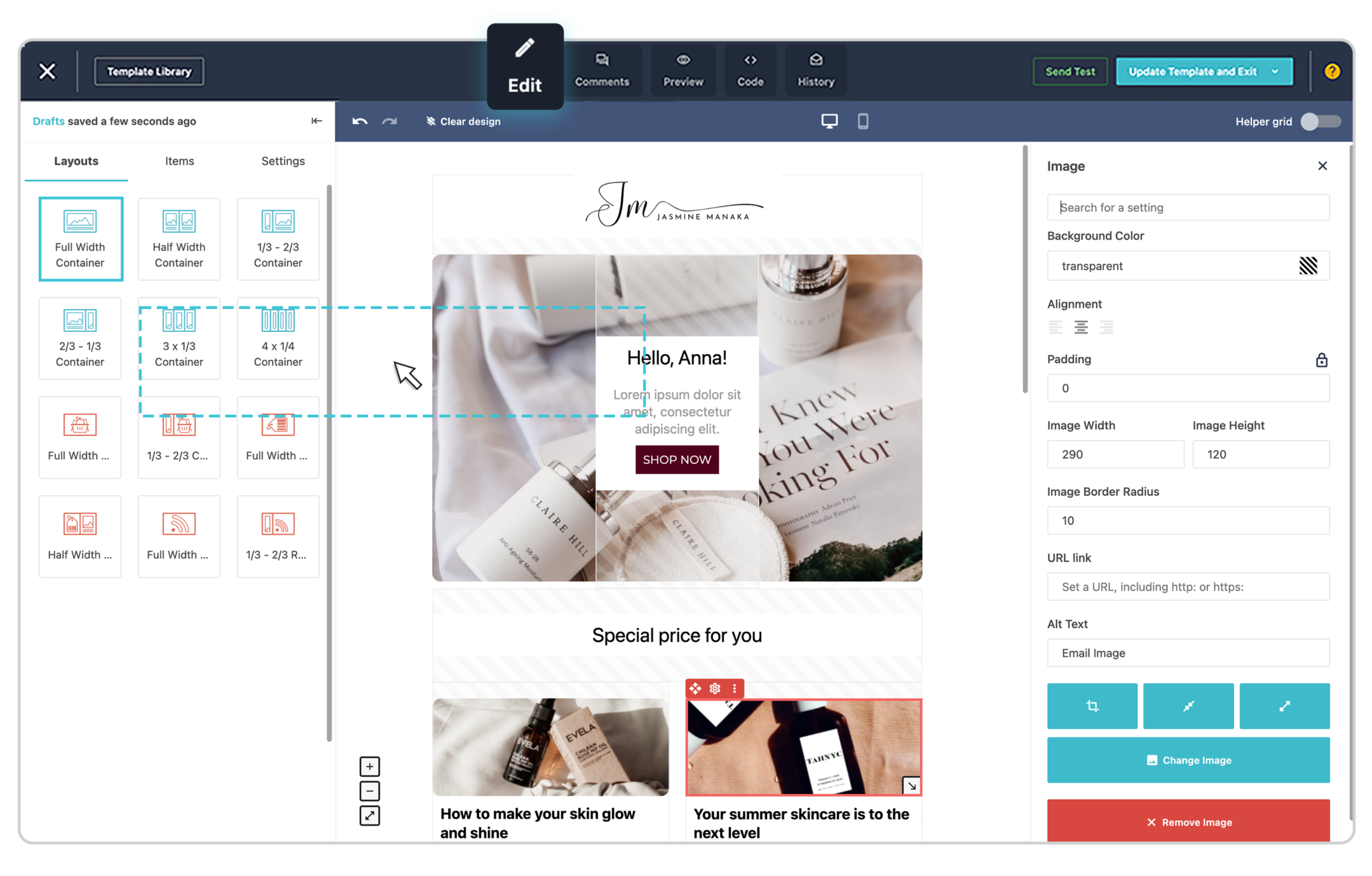
Also, it offers scalable pricing, making it easy to start small and grow your email marketing efforts as your business expands. You can try the email builder and all the features by registering for the 30-day free trial.
3. Craft compelling email content
All email content you send to your audience must be well-crafted and, most importantly, relevant to the audience segment you send it to.
Examples of construction-industry relevant content include:
- Project showcases: Highlight recently completed projects to prospective clients.
- Case studies: Demonstrate your high-quality work and build trust by sending case studies or customer success stories to your clients.
- Industry news and safety tips: While not necessarily relevant to all the subscribers on your email list, it’s good to send industry updates and safety tips to those segments it will resonate with.
Personalization of your email content is also crucial, otherwise, you risk wasting your time sending irrelevant email content that could ultimately cause people to unsubscribe.
Here’s an example from Park Construction’s newsletter:
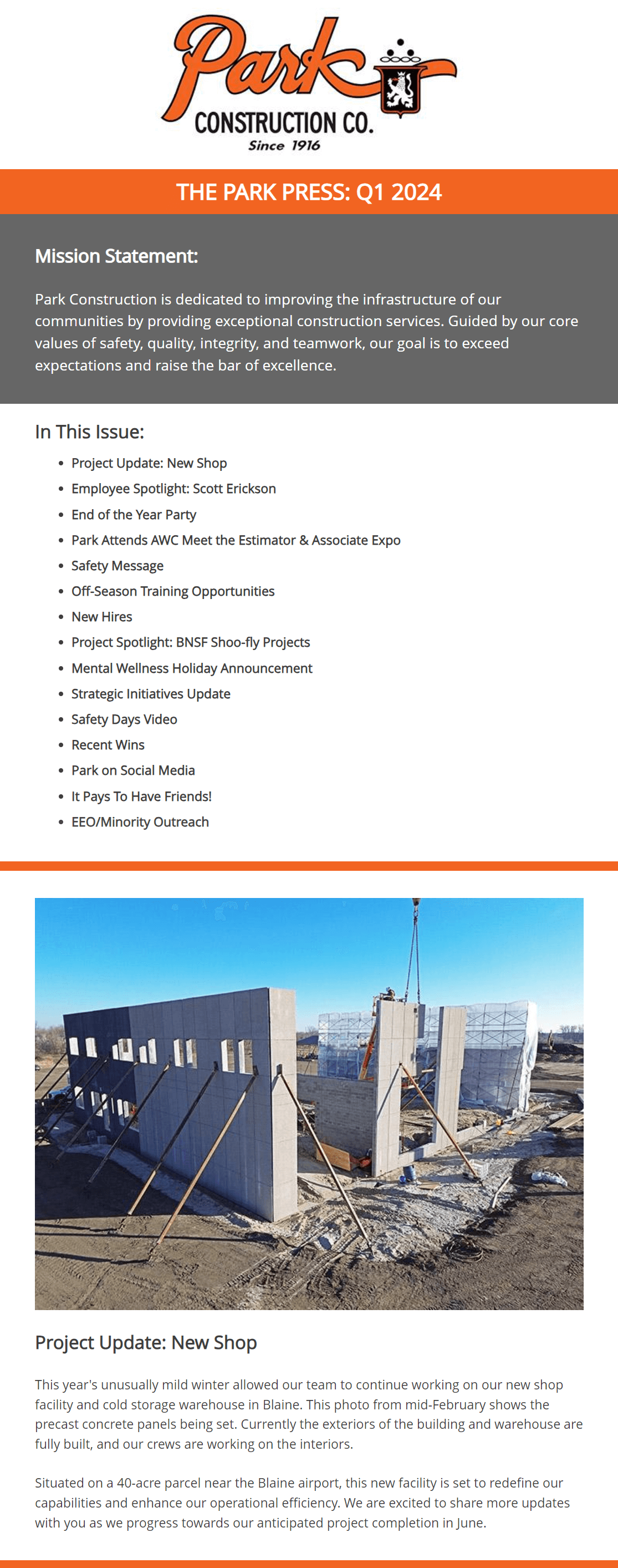
In their Spring 2024 email, the company covers the following:
- New shop construction progress, showcasing ongoing efforts and future capabilities.
- Contributions of long-term employees, fostering a sense of community and appreciation.
- Company events and industry expos, reinforcing company culture and networking efforts.
- Safety achievements and future training opportunities, underlining the company’s commitment to safety.
- Strategic goals and recently secured projects, demonstrating growth and future plans.
That’s a beautifully-structured campaign to engage their audience and promote their brand.
4. Develop email sequences
Email sequences or drip campaigns are a series of automated emails that are delivered to your subscribers at set intervals.
They can be used for various email campaigns like a series of welcome emails and onboarding campaigns.
Below, you’ll find a simple drip campaign sequence with numerous emails to show you how to plan yours:
Welcome Email (Day 1)
- Subject: Welcome to [Construction Company Name]!
- Content: Welcome message, introduction to the company, overview of your construction services, and contact information.
Project Preparation (Day 3)
- Subject: Preparing for Your Upcoming Project
- Content: Details on the initial steps, what the client can expect, and key contacts for any questions.
Meet the Team (Day 7)
- Subject: Meet Your Project Team
- Content: Introduce the project manager and key team members, their roles, and how they will assist.
Project Timeline (Day 10)
- Subject: Your Project Timeline
- Content: Outline the project timeline, key milestones, and what the client should expect during each phase.
Progress update (Day 14)
- Subject: Your Project Progress
- Content: Provide a brief update on the project’s status, any completed milestones, and upcoming tasks.
Further reading: Ensure your welcome emails make a great first impression. Look at some welcome email examples to get inspired and then use our welcome email templates to get started.
Step 5. Avoid spam folders
After spending time crafting the perfect email content for your subscribers, the last thing you want is for it to end up in their spam folder. Luckily, there are steps you can take to avoid this fate.
Firstly, you need to monitor your sender score or sender reputation. A low sender score significantly reduces your email deliverability and heightens the chances your email will be sent to the spam folder.
A good way to minimize this risk is to use a reputable email service provider with a strict email approval process so you won’t be sharing your IP address with spammers. Then, you can follow these steps to keep away from the spam folder:
- Avoid using spam words in your subject lines as they’ll likely get caught in the spam filter.
- Make your subject lines clear and related to the content of the email without being overly pushy.
- Embed your content directly in the email copy—there’s no need to add lots of attachments.
- Ensure your subscribers consent to receive marketing and transactional emails using opt-in, permission-based subscription forms.
Lastly, establish a sending schedule that works for your email list. Sending too often will reduce your sender reputation and ultimately annoy your recipients, but sending too little will cause you to fall off their radar.
Further reading: Take a look at our guide to find the best time to send your emails according to data.
6. Track your campaign results
Setting goals for your email campaigns is crucial. It gives you something to work toward, and you can assess whether or not your efforts are bringing you closer to your goal.
Some examples of campaign goals could include:
- Increase website traffic by X% by the end of Q4
- Generate X new leads in Q1
- Receive X project inquiries by summer
Ensure you set SMART (specific, measurable, achievable, realistic, and time-bound) goals.
When you’re done, you can start monitoring key email metrics, such as:
- Open rate: Percentage of recipients who open your email. Indicates the effectiveness of your subject lines and email timing.
- Click-through rate (CTR): Those who clicked on a link within your email. Shows the engagement rate and relevance of your email content.
- Unsubscribe rate: Recipients who opt out of your emails. Helps identify if your content is resonating with your audience.
- Conversion rate: Subscribers who completed a desired action (e.g., signing a contract). Measures the effectiveness of your email in driving actions.
- Bounce Rate: Emails that couldn’t be delivered. Indicates issues with your contact list quality.
Tips for Successful Construction Email Marketing Campaigns
Before you dive into building your first construction email marketing campaign, we’ve compiled a list of six top email marketing tips to guide you through the process.
Craft compelling subject lines
Your email subject line is the first thing your recipient will see and it should compel them to open the email. Some of the top subject line best practices to follow include: making them clear, informative, and attention-grabbing without being too long or including any spam words.
Here are some examples for different email types:
- Welcome email: Welcome to [Company Name]! Let’s Build Your Dream Project
- Project update: Exciting Progress: Your Project Timeline and Milestones
- Safety tips: Top Safety Tips for Your Construction Site
- New service announcement: Introducing Our New Renovation Services!
- Feedback request: We Value Your Opinion: Share Your Project Experience
You can also judge the performance of your subject lines by monitoring your campaign’s open rate.
If you need a hand, though, you can use a subject line tester like Refine for free tips on improving your subject line to increase your open rate.
Designate a dedicated email writer
Maintaining a cohesive and consistent voice and style in your email campaigns is crucial as the recipient will become familiar with the tone of voice over time. This helps to develop relationships as your subscribers will feel they know the person emailing them.
A simple way to guarantee this is by having a dedicated writer (or team) that develops your email copy for every campaign.
Additionally, create an email calendar to track your campaigns, deadlines, and team responsibilities. This organization helps maintain consistency and ensures timely execution of your construction company email marketing strategy.
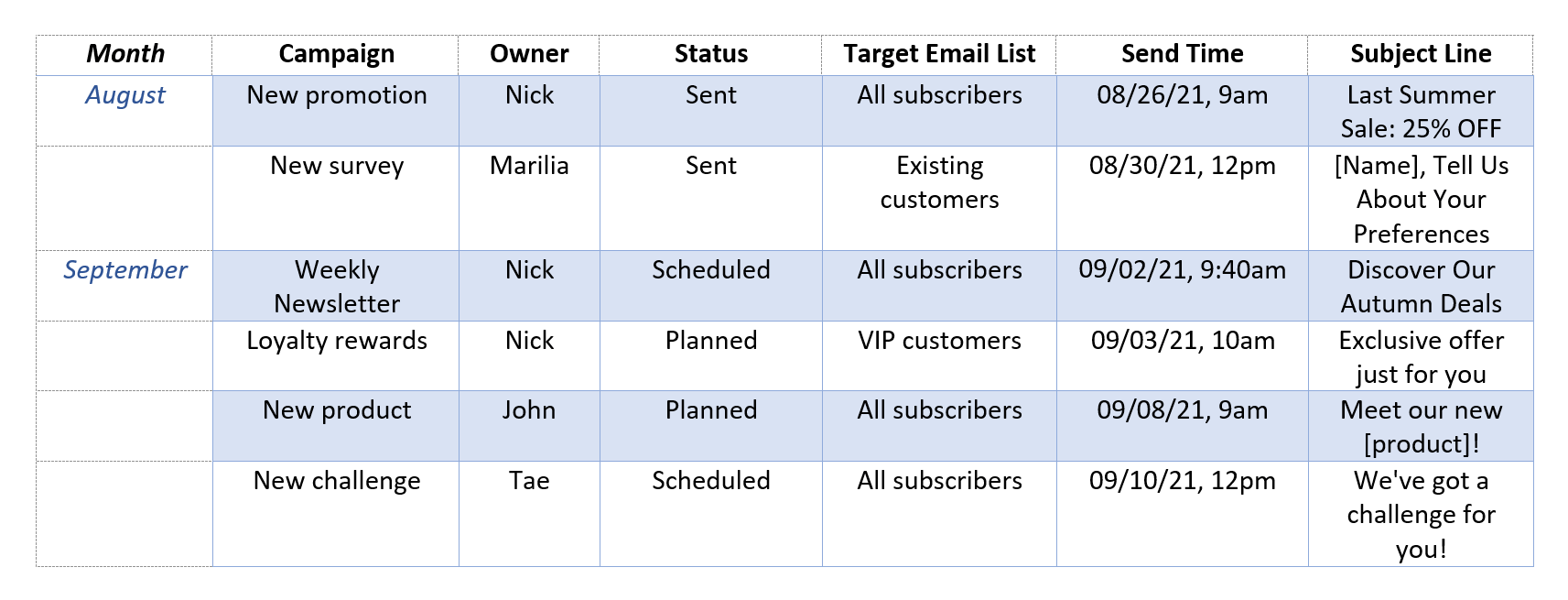
Ensure flawless mobile optimization
A vast majority of email content is viewed on mobile devices today, so if you’re not optimizing your campaigns for mobile, you’re missing out.
Focus on using responsive designs and large fonts and buttons, and keep your emails concise to ensure an enjoyable experience for mobile readers.
Here are some tips to ensure mobile-friendly emails:
- Responsive design: Use flexible email designs that adjust to different screen sizes.
- Large fonts and CTA buttons: Make text and clickable elements easy to read and interact with on small screens.
- Short copy: Keep emails brief and to the point to maintain reader engagement.
- Single-column layout: Simplify navigation and improve readability on mobile devices.
Integrate clear calls to action
A clear, persuasive CTA should be included in every email you send.
It can take the form of a link within the text but ensuring it stands out is vital. This is why using a button in the email design that links to your desired landing page is often a better method of including CTAs in your email content.
Tell the reader exactly what you want them to do next, such as visit your website, download a resource, or contact you for a quote.
Keep the CTA short and direct for best results, and monitor your click-through rate and heat map (where readers clicked the most in your email) to see how well it performed.
Follow email marketing regulations
Failure to comply with email marketing regulations, like CAN-SPAM and GDPR, is a surefire way to grind your efforts to a halt.
Ensure you gain explicit permission before adding a subscriber to your email list, and include clear unsubscribe instructions in every email. Failure to do so can get you flagged for sending spam emails.
A/B test for continuous improvement
A/B testing your emails is a powerful tool for optimizing your email campaigns. The process involves sending different versions of your emails with alternate subject lines, CTAs, or email layouts, to see which one performs best.
Monitor the key metrics for campaign performance through your email service provider’s reporting analytics and use the data to inform your future campaigns.
Time to “Construct” Your Email Strategy
Construction email marketing has a high ROI and, when done correctly, gives you a competitive advantage in your industry.
Getting started might feel like a daunting task, but it doesn’t have to be. An email marketing platform like Moosend streamlines your email marketing efforts, from ideation to design to delivery and everything in between.
With set-and-forget automation flows, you can put your energy where it needs to be—on the construction projects that are flooding in thanks to your new-and-improved marketing strategy.
Sign up for a free trial of Moosend today and discover how email marketing can grow your construction business.
Frequently Asked Questions
Here are the answers to common questions around construction company email marketing.
1. What Are the Benefits of Email Marketing for Construction Companies?
Email marketing offers numerous benefits for construction companies, including enhanced communication with clients and stakeholders through regular project updates and news. It promotes lead generation by showcasing completed projects and expertise, and helps maintain customer retention by providing valuable content such as maintenance tips and industry insights.
2. Do contractors need email marketing?
Short answer—yes! Email marketing assists with lead generation, brand awareness, customer engagement, and—perhaps most importantly—customer relationship-building. A well-thought-out email marketing strategy will keep your construction business top-of-mind and help with repeat business.
3. Can I start email marketing for free?
Yes, some companies offer free email marketing services to help you get started, but these often come with limited features. While free plans are great for beginners, they may lack the advanced tools needed for effective campaigns, such as automation, in-depth analytics, and extensive customization options. It’s better to invest in a scalable marketing tool that grows with your needs. For instance, Moosend offers a robust platform with scalable pricing, allowing you to access more features and capabilities as your business and email list expand.





 Published by
Published by
